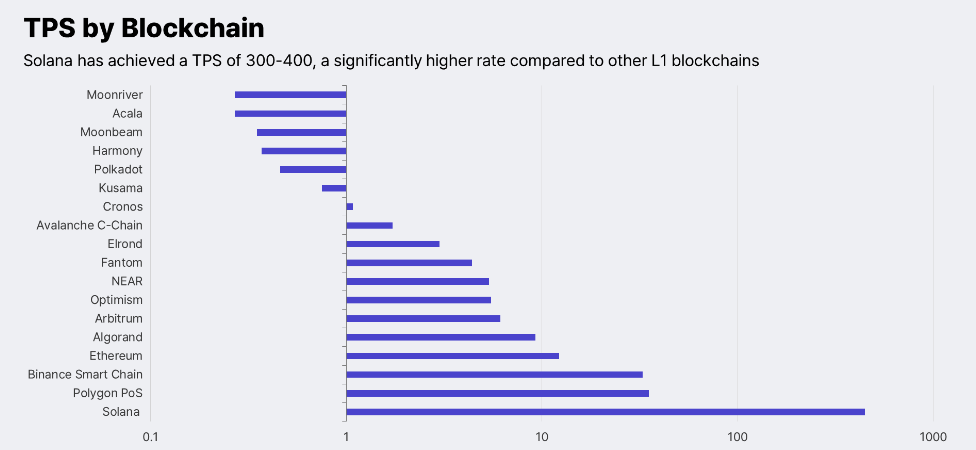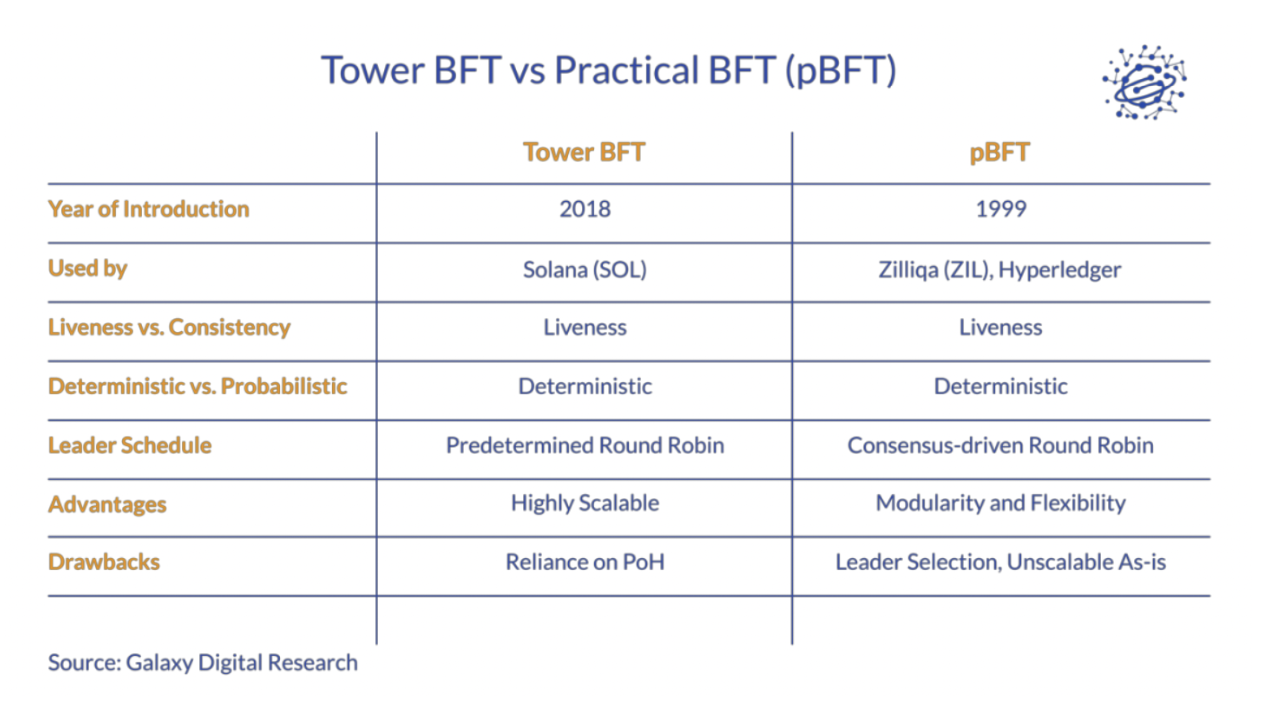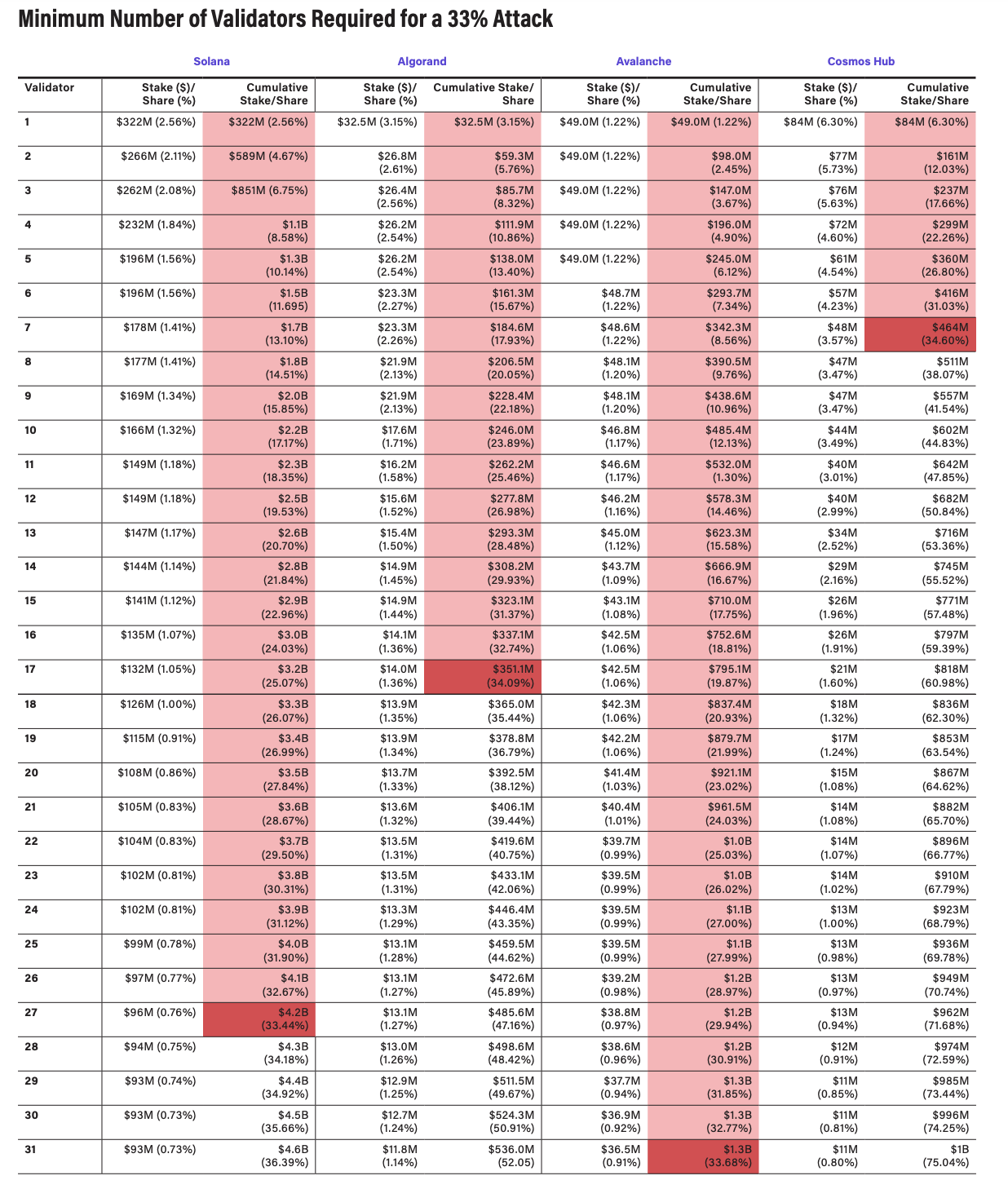
With a leader rotation removing delays, the Solana network is able to reach speeds not seen in most other blockchain networks to date. Solana has achieved approximately 50,000 TPS in a testnet environment. However, its execution engine doesn’t delineate between messages such as votes cast in consensus (which nonetheless require payment of transaction fees) and more typical peer-to-peer value transfers and smart contract transactions.
Transactions on Solana can be divided into either consensus votes or token transfers and smart contract logic. Non-vote transactions are analogous to EVM transaction counts and represent the actual economic activity on the network. If validators on the network increase, then the number of vote transactions also increases regardless of any meaningful financial activity or adoption.
This means TPS numbers purported by Solana aren’t an “apples-to-apples” comparison with most other chains that don’t count such metrics. This is because Solana is (one of) the only blockchains that hold consensus votes on chain—a process that accounts for up to ~85% of the TPS numbers. Filtering for consensus votes, Solana operates much closer to 300-1,000 TPS depending on the period but still processing more transactions than other EVM chains.
 Source: Delphi Digital
Source: Delphi Digital
Hence, testnet levels are likely overstated compared to other platforms due to how transactions are defined. Additionally, this throughput was achieved with about 200 nodes, which is about one-third of the nodes currently on its mainnet, and communication overhead in a production environment is likely higher.
For comparison, here are the speeds of other comparable networks:
- Bitcoin -
- Polygon - 50 TPS
In addition to PoH, Solana uses a unique take on the Practical Byzantine Fault Tolerance (PBFT) in the form of a consensus algorithm called “Tower BFT.” This is a complementary layer to PoH, helping to optimize the entire consensus process. In short, Tower BFT leverages the sequentially generated clock from PoH. Because transaction execution is separated from finality thanks to the combination of PoH and PoS, Solana can operate with ~400 milliseconds block times, one of the fastest in the industry. In practice, a transaction is considered final on Solana once it has received 31 block confirmations (~12 seconds). Anything less is technically still a pending transaction.
Additionally, over the course of 2022, Solana's network consistently improved. In H2 2022, the average block time decreased significantly. This is partly due to an increase in the ratio of vote transactions to non-vote transactions (as vote transactions require less computational power) but also as a result of various software upgrades to the network. The NFT minting/spam problem, which had caused intermittent downtime on the Solana network in the past, has had a reduced impact in recent months, and the situation is expected to continue improving with the implementation of solutions such as QUIC, fee markets, Jito, and Firedancer.
 Source: Galaxy Digital
Source: Galaxy Digital
Validators
validators stand as guardians of networks like Solana, wielding immense influence over their security and operational prowess. This article aims to demystify the roles and responsibilities of validators in the Solana ecosystem and highlights the significance of diversity among validator clients, a factor crucial to maintaining network resilience.
Validators Unveiled: Backbone of Solana
At its core, a validator is essentially a sophisticated computer system that actively engages in the operations of a Proof of Stake (PoS) blockchain network, and Solana is no exception. These validators bear the weight of responsibilities ranging from processing transactions to actively participating in the consensus mechanism that underpins the network's functionality.
What truly sets Solana's validators apart is their financial commitment to network security. To become a validator, one must lock up a certain quantity of Solana's native token, akin to a security deposit in the traditional financial world. This financial commitment acts as a direct alignment of the validator's interests with the network's welfare. Validators are not only incentivized financially to perform their tasks accurately and efficiently but are also subject to penalties for any malicious or faulty behavior. This checks-and-balances approach, known as slashing, entails a reduction in a validator's stake for improper conduct, ensuring that they remain committed to upholding the network's integrity.
Validator clients are specialized applications that validators employ to fulfill their roles within the Solana network. These clients form the backbone of a validator's operation, providing them with a unique cryptographic identity that is essential for participation in the consensus process.
The concept of validator client diversity is a cornerstone of the Solana ecosystem, playing a pivotal role in safeguarding the network's robustness and fault tolerance. Diversity, in this context, refers to the existence of multiple distinct implementations of validator clients that validators can choose to employ.
The importance of diversity becomes evident when one considers scenarios where a particular client implementation faces issues, such as a crash or a critical bug that affects network liveness. In Solana, if no single client controls more than 33% of the stake, the network can withstand such challenges without significant disruption. Moreover, if a client experiences a bug resulting in an invalid state transition, the network can avoid catastrophic failure as long as less than 33% of the stake relies on that specific client. The majority of the network remains on a valid state, preventing the emergence of a split or fork in the blockchain.
 Source: Kraken
Source: Kraken
Measuring the diversity of clients involves considering both the percentage of stake channeled through each client and the total number of distinct clients available. As of the latest data, Solana boasts a robust network comprising 1979 validators. Notably, the two primary clients in use on Solana's mainnet are those provided by Solana Labs and Jito Labs.
Solana embarked on its journey with a single validator client developed by Solana Labs in March 2020. However, in August 2022, Jito Labs introduced a second validator client, a derivative of Solana Labs' code but tailored to maximize the extraction of Maximal Extractable Value (MEV) within blocks. An intriguing feature of this client is its ability to create a pseudo-mempool, allowing validators to efficiently bundle transactions and submit them to Jito's Block Engine.
As of October 2023, the distribution of active stake reflects Solana Labs' client holding the majority at 68.55%, with Jito's client claiming 31.45%. Notably, there has been a 16% increase in the number of validators adopting Jito's client since the previous Solana Foundation Health Report. This uptrend signifies a positive shift towards greater diversity among validator clients within the Solana ecosystem.
When nodes vote on a fork, they’re locked out for a certain amount of time until a particular vote reaches a 232 timeout for the fork. This disincentivizes malicious activity as rewards are only paid out when this timeout is achieved, which is highly likely to be that in which the majority of nodes voted. The fork reaching this is also going to be the heaviest fork with the most rewards, further incentivizing each validator node to choose that fork. Doing so ensures each validator isn’t locked out of the network. Due to the nature of PoH, any participating node can compute the timeouts for everyone else. This means peer-to-peer communication (P2P) isn’t required.











